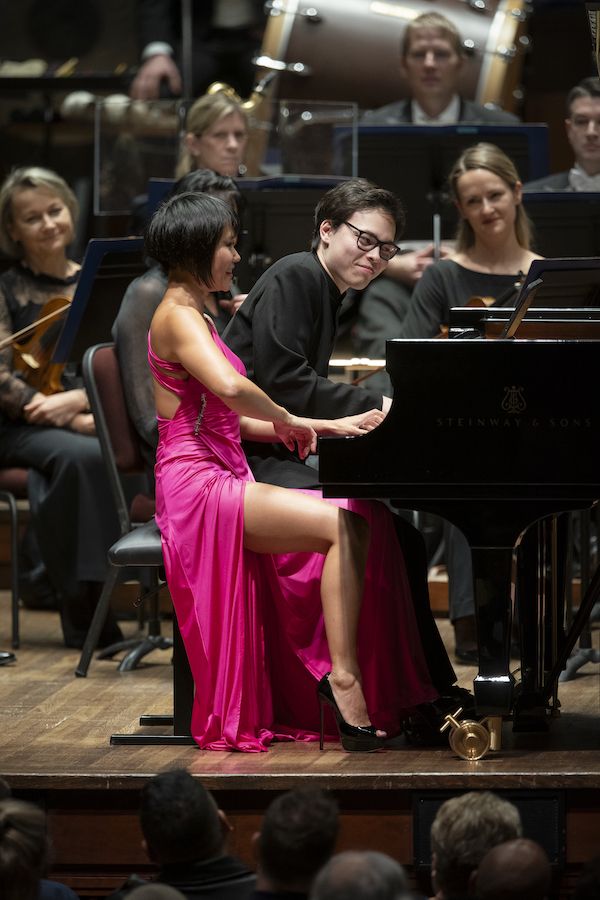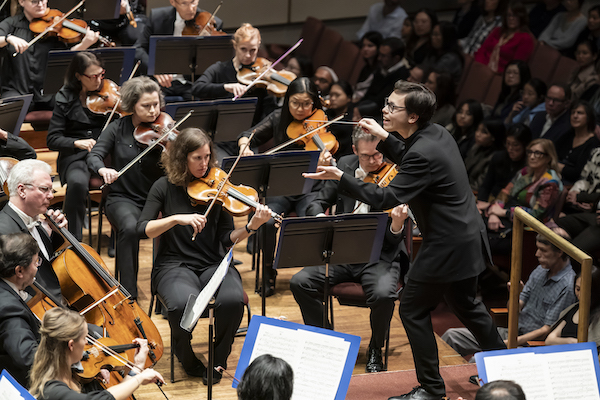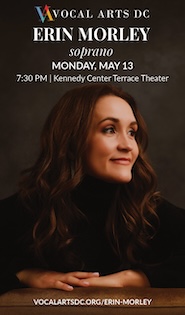Wang lights a fire and young conductor throws on the gas in blazing NSO concert

Conductor Tarmo Peltoski and soloist Yuja Wang play a Brahms encore duet following Wang’s performance of Bartok’s Piano Concerto No. 2 with the National Symphony Orchestra Thursday night. Photo: Scott Suchman
It’s hard for anyone to upstage Yuja Wang. The 36-year-old pianist, clad in hot pink and stiletto heels for her latest appearance with the National Symphony Orchestra, has been a Wunderkind for a decade and a half. Yet she was the veteran presence Thursday night on stage with Tarmo Peltokoski making his NSO debut. The 23-year-old Finnish conductor took the podium in a cloud of brash and youthful confidence.
Peltokoski’s first musical love reportedly was Wagner’s operas, which drew him into conducting in childhood, and he opened the evening with the Prelude to Wagner’s Die Meistersinger von Nürnberg. The young Finn, who often stood with legs spread apart, has a crystal-clear stick technique and bold ideas. The execution, while exciting, lacked cohesiveness in the ensemble alignment at times and was often careless in its enthusiasm.
His willingness to throw himself over the edge, especially in terms of sheer velocity, made him an ideal partner for Yuja Wang, who appeared as soloist in a death-defying rendition of Bartók’s Piano Concerto No. 2. The tempo of the first movement, in which the strings do not play at all, was blistering at the start, only seeming to accelerate as the hammered octaves and chords, in endless spiraling runs, gave way to even more rapidly moving triplets.
Peltokoski let the NSO overrun Wang, or at least try to, with the many layered fanfares of brass and woodwinds rolling over the piano. When, signaled by a few timpani strikes, Wang could let go in the cadenza near the end of the movement, she unleashed an even more torrential outpouring of loud, spiky figuration.
The outer sections of the second movement featured quintal string writing so ethereal, with mutes on and senza vibrato, that several watch beepers in the audience easily overpowered it. Between forthright passages accompanied by timpani, creating an overall arch form for the concerto, Wang’s Presto middle section exploded in a buzz of scales, trills, and tremolos.
Peltokoski turned calm in the finale, a good counterbalance, with minimal gestures to keep track of the rapidly shifting metrical patterns, through which Wang tore with reckless abandon. With all parts of the orchestra churning out sound, the concerto grew more and more raucous, with the bass drum pounding a relentless beat. At the same time, Bartók wove in some more romantic harmony toward the end, a balm amid so much pointed dissonance.
In a surprise move, which they have repeated at previous concerts, Peltokoski accompanied Wang to the bench for her encore and then sat down with her to play two four-hand Hungarian Dances of Brahms (Nos. 1 and 5) served up with plenty of antic charm. A stylish nightcap to an electrifying performance.

Tarmo Peltoski conducted the NSO in music of Wagner, Bartok and Sibelius Thursday night. Photo: Scott Suchman
Peltokoski did his utmost to bring the same intense voltage to Sibelius’s First Symphony, which concluded the concert. The interpretation was most effective, however, in its quietest moments. Principal clarinetist Lin Ma expertly spun out the first movement’s opening solo, a long passage over a timpani roll that presents all the symphony’s main themes. Sibelius biographer Andrew Barnett has characterized the musical style of this E minor symphony as being an homage to Italian verismo opera, an idea that grows on you as you listen to the whole work.
The Allegro portion of the first movement, though, rushed headlong, with Peltokoski moving far too briskly, a fault that ran through much of this interpretation. Big brass climaxes felt overpowered, and even the second movement moved too rapidly, especially since the lush sounds from strings and winds could have lingered more than they did. Only in the coda, where the conductor slowed things down considerably, did the movement take on that needed nostalgic tone.
The Scherzo, like the four-hands encores, was heavy on playful extremes but lacking in subtlety, with the tempo moving so hastily that the interplay of hemiola structures could barely land on the ear. The musicians, even so, accomplished some remarkable things, including spectacular playing from the horn section and plush sound from the woodwinds and harp. (Peltokoski may have been trying to hew to the metronome markings that Sibelius later added to the score, but Barnett has warned that “it is unwise to treat [them] as sacrosanct.”)
At the opening of the Finale, the opening “verismo” music of the clarinet solo returned, this time in a wall of violin sound accompanied by funereal brass. Of all the movements, Peltokoski’s urgency made the most sense in this movement, which Sibelius marked “Quasi una fantasia,” implying a series of quicksilver contrasts, which it was. Like its inspiration, it ended tragically and in stark minor harmony.
The program will be repeated 8 p.m. Saturday and 3 p.m. Sunday. kennedy-center.org


